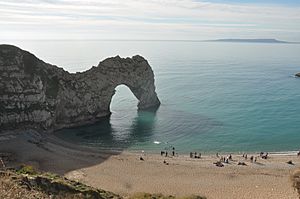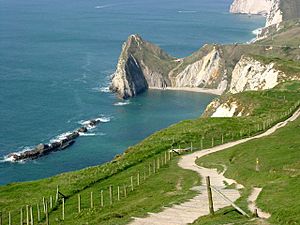Durdle Door facts for kids
Durdle Door is a famous natural rock arch found on the Jurassic Coast in Dorset, England. It's close to a village called Lulworth. This amazing arch is made of limestone rock. A family called the Welds own the land, which is part of the Lulworth Estate, but everyone is welcome to visit this beautiful spot.
How Durdle Door Was Made
The shape of the coastline around Durdle Door is special because of the different kinds of rocks there. Some rocks are very hard, and others are soft. There are also natural cracks and folds in the rock layers.
Imagine the layers of rock standing almost straight up, like books on a shelf. The hardest rock, called Portland limestone, was originally right along the shoreline. This is the same type of rock that forms the narrow entrance to Lulworth Cove, about a mile away.
Behind this hard limestone was a band of much softer rocks, about 120 meters (390 feet) thick. And behind those soft rocks was another strong, thick layer of chalk. These steeply tilted rocks are part of a larger geological feature called the Lulworth crumple. They were formed millions of years ago when huge mountains, like the Alps, were being created.
Over a very long time, the sea slowly wore away (this is called erosion) most of the limestone along this part of the coast. What's left of the limestone forms the small headland where the arch is. The sea kept eroding the rock, especially at the western end of the limestone band, until it punched a hole right through, creating the Durdle Door arch we see today.
Teams from UNESCO (an international organization that protects important places) keep an eye on the condition of the arch and the nearby beach.
The narrow strip of land that connects the limestone arch to the chalk cliffs is about 120 meters (390 feet) long. It's made up of different rock types, including more Portland limestone, and thinner bands of clay, sand, and other rocks.
Just east of Durdle Door, there's a small bay called Man O' War Bay. Here, some of the hard limestone hasn't been completely eroded away. You can see it sticking out of the waves as the Man O' War Rocks. To the west, offshore, there are also small rocky islands formed from the eroded limestone. They have fun names like The Bull, The Blind Cow, The Cow, and The Calf!
Because the cliffs here are always being worn away by the sea, sometimes rocks can fall or land can slide. A big slide happened near Durdle Door in April 2013, which damaged part of the walking path along the coast.
What Does 'Durdle Door' Mean?
There aren't many old written records about Durdle Door, but its name is very old, probably over a thousand years old! In the late 1700s, people described it as the "magnificent arch of Durdle-rock Door." Later maps in the 1800s called it "Duddledoor" or "Durdle Door."
The word Durdle comes from an old English word, thirl, which means to pierce, bore, or drill a hole. This makes a lot of sense for a rock arch! You can find similar names in other places nearby, like Durlston Bay and Durlston Head, or Thurlestone in the next county over, which also has an arched rock.
The Door part of the name probably means what it does today, referring to the arch's shape. In the late 1800s, some people even called it the "Barn-door." It was described as being tall enough for a good-sized sailing boat to pass through it!

Images for kids
-
People on the beach show the scale of the arch. The Isle of Portland can be seen on the horizon.
See also
 In Spanish: Durdle Door para niños
In Spanish: Durdle Door para niños




